|
lick pictures for a larger version.
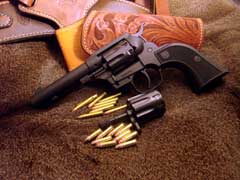
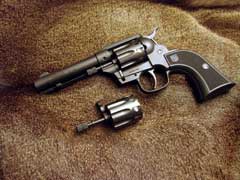
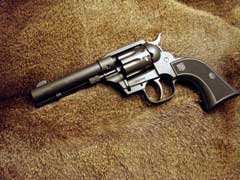
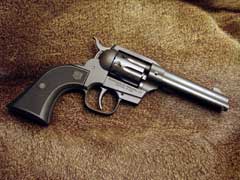
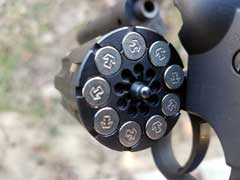
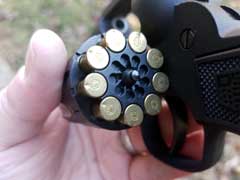
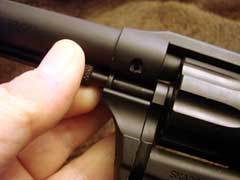
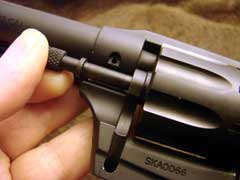
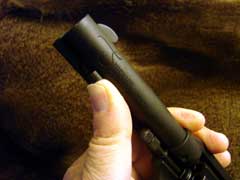
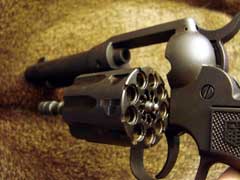
Two methods for opening the cylinder.
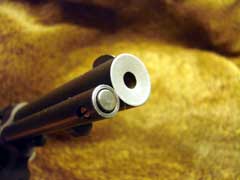
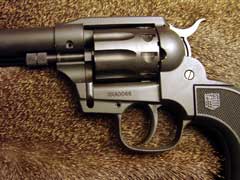
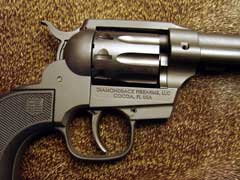
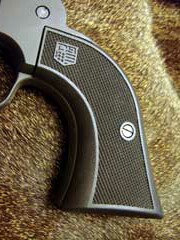
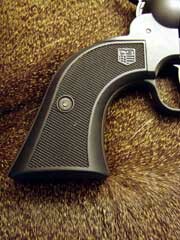

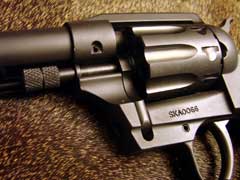
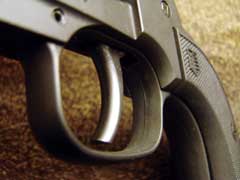
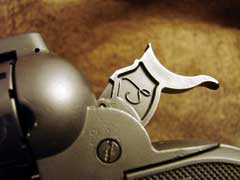
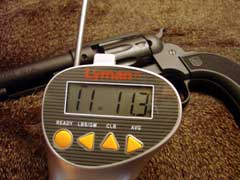
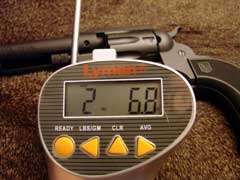
Double-Action (top) and Single-Action (bottom) trigger pull.
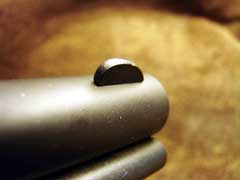
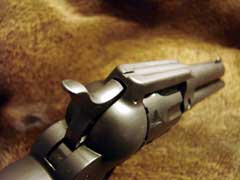
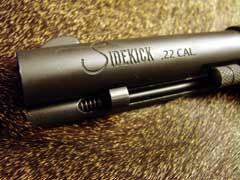
|
|
Times
change, but people do not.
When
I was about eight years old, my Dad took me and my brothers to a
Sheriff's Department auction on the Town Square in Clarksville,
Tennessee, which is the County Seat of Montgomery County, where
my Mom and Dad raised four mean little boys to be the best men
they could be. Back in those days, the Sheriff's Department
would raise funds by conducting annual auctions of everything
from tools and knives to cars and guns seized during
investigations. It was always exciting to go to auctions with my
Dad, whether they were livestock auctions, farm implement
auctions, estate auctions, or Sheriff's auctions, because you
never knew what Dad would bring home; he almost always brought
home something interesting. THIS auction, though, was more
exciting than most, as I had saved up a few dollars of my own,
and Dad said if they had something I could afford, I could buy
it. I had never owned a "real" gun before, but it was
my hope that I could find an affordable handgun that would allow
me to emulate the dashing "Cowboys" from the Saturday
TV movie matinees. I don't remember how many guns the Sheriff's
Department had up for sale that year, but I do remember that
they had an old Harrington & Richardson Model 929 nine-shot
double-action 22 revolver. The old H&R was a little rusty,
but Dad said it was mechanically in good shape and had no
problems that gun oil and elbow grease wouldn't fix, and it was
a REVOLVER. Revolvers have held a special fascination for me all
my life, and while the H&R didn't really look like a Cowboy
gun, it did have enough of the "Old West That Never
Was" coolness about it that it became the first gun I ever
"HAD" to have. I was a little nervous about whether I
could afford it or not, but I REALLY wanted it, and I think some
of the other bidders decided to take it easy on the Kid, so the
gavel hammered down on my winning bid of seven dollars. I still
remember being all puffed-up with pride as I went forward with
my seven bucks (which was a not-inconsiderable sum for an
eight-year-old kid in the late 1960s), shook the Deputy's hand,
and walked away with my Prize. As
I said,
times change!
Also
as I said, people do not change. That old H&R started me
walking the path that I still walk to this day: I have plenty of
long guns, but I have always been more of a Handgunner, and my
collection is definitely reflective of that. I wish I knew what
ever became of that first Model 929, but the old H&Rs have
never lost their charm for me, and I own a good number of them
now, including a very nice Model 929.
My
mind flashed back to all this when I first saw a pre-production
Diamondback Sidekick in
October 2021 at a Writer's Conference at the Texas Gun
Experience in Grapevine, TX. We have known the fine folks at
Diamondback for many years, first testing their DB380
380 ACP pocket pistol, then their revolutionary DB9
9mm pocket pistol, their now-discontinued full-size DBFS
9mm pistol, and their DB10
semi-auto 308 rifles. My brother Jeff and I visited
the Diamondback factory in 2017, where we marveled at the modern
manufacturing processes that allow Diamondback to control
in-house all facets of manufacture, and had
a lot of fun riding around in a Diamondback Airboat.
I
had not heard anything in advance about the development of
Diamondback's first-ever revolver, the Sidekick, so when I first
saw it at the Writer's Conference, I was floored. Here we are,
in a world of plastic semi-auto pistols and AR-style rifles, and
one of today's finest makers of Modern firearms has developed a
22 revolver that made me feel like an eight-year-old kid again!
With all the modern semi-auto rifles and pistols on display, I
(along with a couple of the more Old-School gun writers in
attendance) were immediately drawn to the Sidekick.
At
first glance, the Sidekick resembles any number of 22
Single-Action sixguns on today's market, and it will fit
holsters made for these sixguns (more on that later), but one
quickly realizes that the Sidekick is neither a Single-Action,
nor a sixgun!
Firstly,
the Sidekick is a Double-Action or Single-Action revolver. For
those who need these terms defined, a Single-Action's trigger
system completes only one action: the trigger will release the
hammer to fire a cartridge only after the hammer has been
manually cocked, while a Double-Action's trigger system will
both cock and release the hammer in one stroke. The trigger pull
on a Double-Action is longer and heavier than a Single-Action as
a result, so many use the Single-Action system for
precisely-aimed fire, and the Double-Action system for rapid
fire. The Sidekick has the look and feel of a Single-Action, but
can be used either a a Single or Double-Action. My Sidekick's
Double-Action trigger is quite heavy, measuring 11 pounds, 11.3
ounces on my Lyman
Electronic Digital Trigger Pull Gauge, but although heavy,
the Double-Action pull is "front-loaded"; the
heaviness of pull is encountered after a slight takeup, and
smooth over the trigger's travel. The Sidekick's Single-Action
pull is an excellent and smooth 2 pounds, 6.8 ounces, with zero
takeup and slight overtravel.
Secondly,
the Sidekick features a nine-shot cylinder, but the difference
between it and a sixgun does not end with the Sidekick's 50
percent capacity advantage. Although the Sidekick looks very
much like the typical Single-Action sixgun, the cylinder swings
out for loading / unloading, as is commonly seen on the more
modern 20th Century Double-Action revolver designs. To maintain
the appearance of the Cowboy-style sixguns, the Sidekick
eschews the cylinder latching mechanisms of typical
Double-Action revolvers, and there are two methods of releasing
the cylinder. The cylinder base pin can be easily grasped and
pulled forward, releasing the cylinder to swing outward to the
Port side of the revolver; this is how the old H&R design
worked, and was thus the way I instinctively operated the
Sidekick. The second method for releasing the cylinder is quite
ingenious: to maintain the appearance of a Cowboy-style
Single-Action revolver, there is an "ejector rod
housing" mounted to the Starboard side of the barrel, but
since the Sidekick is not a Single-Action revolver, there is no
need for a Single-Action style ejector rod. Pressing what looks
like the ejector rod button forward releases the cylinder to
swing outward. It is a cool option, and allows the ejector rod
housing to have more than a purely aesthetic function.
The
Sidekick ships with two cylinders, one in 22 Magnum, and an
accessory cylinder / crane assembly in 22 Long Rifle. This
allows the 22 Long Rifle (22 LR) cartridge to be safely fired in
the Sidekick. Many 22 Magnum revolvers are pressed into service
as 22 LRs for inexpensive plinking with the lower-powered 22 LR
cartridge, and I often shoot 22 LR in 22 Magnum revolvers
myself, but this is not recommended. The 22 LR cartridge case is
smaller in diameter than the 22 Magnum, so potentially dangerous
case splitting may result when firing the smaller cartridges in
the larger chambers. I have never had a problem doing this, but
tomorrow I might, and the Sidekick eliminates this possible
danger. Another potential benefit of having a second cylinder in
22 LR is that proper chamber dimensions in the 22 LR cylinder
can increase the accuracy of that cartridge. The 22 LR cartridge
can be used for everything from informal plinking to target
shooting and small-game hunting, and the Sidekick is up to those
tasks just as much as the shooter. The more powerful, and more
expensive, 22 Magnum cartridge can take over for medium-size
game, and can actually be used with great effectiveness as a
defensive cartridge against smaller
four-legged and larger two-legged predators.
Swapping
cylinders in the Sidekick is very quick and easy. After opening
the cylinder and assuring that the gun is unloaded, and
double-checking that the gun is unloaded, assure that the gun is
unloaded. Next, depress the link pivot pin at the front of the
frame with a small punch or similar tool (I keep a 1/16"
Allen wrench in the Sidekick's box for this purpose), pull the
cylinder crane out to the left until you feel the crane contact
the punch, then remove the punch. Finally, while keeping a
finger over the link pivot pin hole in the front of the frame,
remove the cylinder / crane assembly; keeping a finger over the
link pivot pin hole will prevent the link pivot pin and spring
from flying into the Wild Blue Yonder, which you do not want to
happen - trust me on this! Installing the second cylinder is
pretty much in reverse order, and the included instruction
manual clearly describes and illustrates the process. After you
do it once to establish the procedure, swapping cylinders takes
far less time than reading this paragraph.
The
Sidekick proved to be 100 percent reliable, and quite accurate
with several different 22 LR and 22 Magnum loads. I did not try
firing 22 LR using the 22 Magnum cylinder, because there was no
need. The sights on the Sidekick will be familiar to anyone who
is experienced with Cowboy-style Single-Action sights: the front
sight is a rounded blade, and the rear sight is the typical
non-adjustable grooved top strap. This type of sighting system
is rugged and offers an acceptable degree of precision, but can
be slow to acquire, especially in varying light conditions. I
have had this type of sight shoot to different points of aim
with the same gun and load, depending on where the sun was
located in the sky during the course of a day. The different
loads used obviously fired to different points of impact,
especially with the 22 LR cylinder, but the Sidekick did shoot
all loads tried reasonably close to the sights. Still, hopefully
soon Diamondback will address this by introducing a Sidekick
with adjustable sights.
To
save on weight as well as manufacturing costs, the Sidekick's
cylinder frame and grip frame are cast from zinc, while the
high-stress components such as berrel, cylinder, and bearing
parts are made of steel. The steel parts are finished in matte
blue, with the zinc parts finished in black Cerakote, resulting
in a pleasing dull-black finish throughout. The grips are black,
checkered, glass-filled nylon, with a Diamondback logo molded
into each side. The grip frame has the familiar Single-Action
"plow handle" shape, and fit the hand quite well.
Specifications -
Diamondback
"Sidekick" 22 LR / 22 Mag Convertible Revolver
| Caliber |
22LR / 22Mag Convertible |
| Action |
Single & Double |
| Cylinder
Capacity |
9 Rounds |
| Barrel &
Cylinder |
Steel, Blued Finish |
| Barrel |
4.5 Inches, 6-Groove, 1:16 RH Twist |
| Barrel
/Cylinder Gap |
0.02 Inch |
| Frame &
Handle |
Zinc, Black Cerakote Finish |
| Overall
Length |
9.875 Inches |
| Weight, Empty |
32.5 Ounces |
| Front Sight |
Fixed Blade |
| Rear Sight |
Integral
Notch |
| Grips |
Checkered Glass-Filled Nylon |
| Trigger Pull,
DA |
11 Pounds, 11.3 Ounces |
| Trigger Pull,
SA |
2 Pounds, 6.8 Ounces |
| Accessories
Included |
Extra 22 Long
Rifle Cylinder & Crane Assembly, Cable Lock, Box /
Manual, Diamondback Bumper Sticker |
| MSRP as of
January 2022 |
$320.00 US |
As I mentioned above, holsters made to fit
the Ruger Single-Six will work just fine for the Diamondback
Sidekick, and I have been carrying my Sidekick around in a
wonderful Single-Six holster made by my friend Mike
"Doc" Barranti of Barranti Leather. Doc Barranti
makes some of the finest holsters ever produced; he makes them
by hand, one at a time, with meticulous attention to function
and detail. Doc is a fine artist whose chosen medium just
happens to be leather. My Barranti
"Tyler Gun Works RSSE Border Ranger" holster was
made to fit my beloved Tyler Gun
Works RSSE Single-Six, and works perfectly for the
Diamondback Sidekick. Barranti also makes a variety of other
holster styles to fit the Single-Six, and will have an option to
suit almost any shooter or budget. The Border Ranger is a
belt-carry holster, but for those of us who prefer a chest-carry
option, Barranti's
Universal Chest Rig is a comfortable, practical, elegant,
and cost-effective way to carry a wide variety of belt holsters
on the chest, for those of us who are more at-ease wearing
overalls or coveralls.
The
Sidekick is styled after the Cowboy-style sixguns of the late
19th Century, takes its function from long-gone variants of the
mid 20th Century, and ups the ante with the modern materials and
manufacturing processes of the 21st Century.
With the introduction of their new Sidekick, Diamondback Firearms has filled a niche that has been too long vacant: a USA-made revolver with 50% greater firepower than your standard single-action sixgun, offering double-action capability with a traditional single-action "Cowboy" appearance. The Sidekick is unique on today's market, and offers great utility and good quality at an affordable price.
Check out the Sidekick at Diamondback Firearms: www.diamondbackfirearms.com.
To Find a Diamondback Firearms Dealer Near You, Click on the DEALER FINDER at Lipsey's:
www.lipseys.com.
To Order Diamondback Firearms Products Online, Click on the GUN GENIE at Davidson's Gallery of Guns:
www.galleryofguns.com.
Order Ammo Online at Lucky Gunner: www.luckygunner.com.
Remington Ammo: www.remington.com.
CCI Ammo: www.cci-ammunition.com.
Armscor Ammo: www.armscor.com/ammo.
Lyman Products: www.lymanproducts.com.
Barranti Leather: www.barrantileather.com.
Boge Quinn
  
Got something to say about this article?
Want to agree (or disagree) with it? Click the following link to
go to the GUNBlast Feedback Page.
|
|
Click pictures for a larger version.
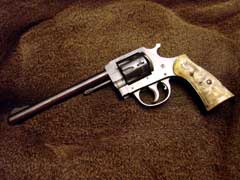
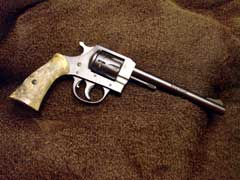
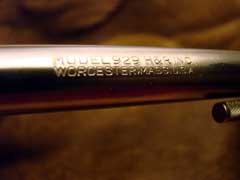
The gun that started it all for Boge: Harrington &
Richardson Model 929 22 Long Rifle.
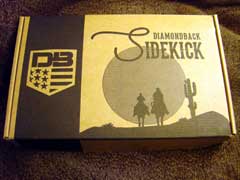
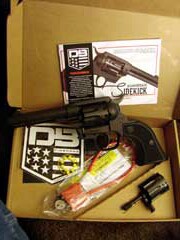

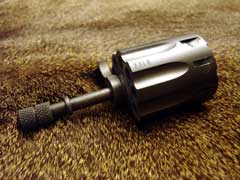
The Sidekick 22 Magnum ships with a second
cylinder/crane assembly in 22 Long Rifle.
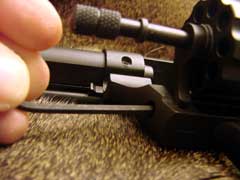
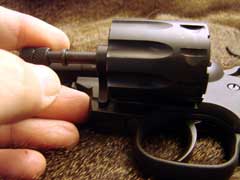
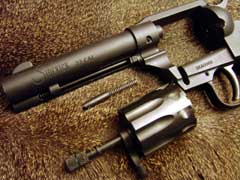
Removing and swapping cylinders is quick and easy.

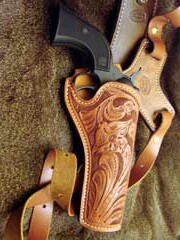
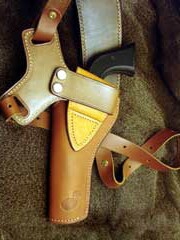
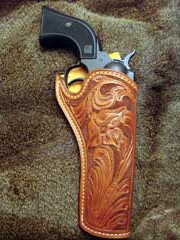
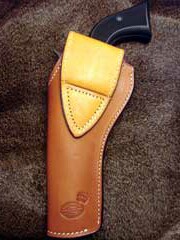
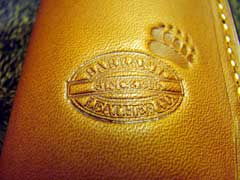
"Tyler
Gun Works RSSE Border Ranger" Single-Six holster and Universal
Chest Rig by Mike "Doc" Barranti of Barranti
Leather.
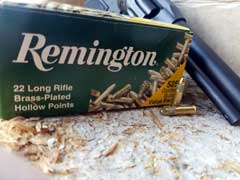
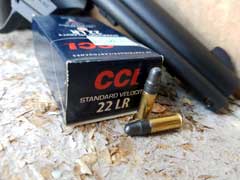
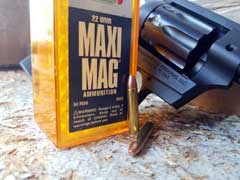
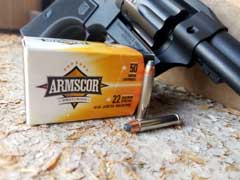
Among the loads tested in the Sidekick were (top to
bottom): Remington "Golden Bullet" HP 22 LR, CCI
Standard Velocity 22 LR, CCI "Maxi-Mag" FMJ-FP 22
Magnum, Armscor JHP 22 Magnum.
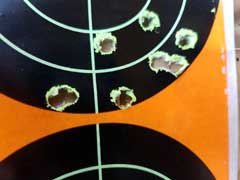
CCI Standard Velocity 22 LR, standing offhand at ten
yards.
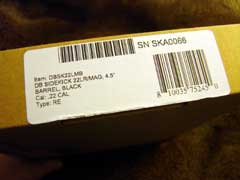
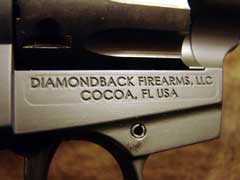
|
![]()